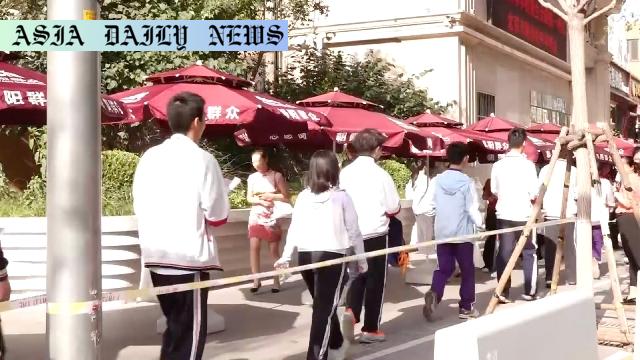College Entrance Exam – China’s national college entrance exam drew over 13 million students this year, showcasing fierce competition and high stakes.
Over 13 million students participated in China’s national college entrance exam.
The ratio of students advancing to higher education in China has doubled in a decade.
Competition for prestigious colleges is intensifying due to economic slowdown and job market challenges.
The number of Chinese students studying abroad, especially in the US, has declined.
Japan is becoming a favoured destination for Chinese students, offering proximity and affordable tuition.

An Overview of China’s College Entrance Exam
The college entrance exam, known as ‘Gaokao,’ is one of the most significant milestones for Chinese students. This exam, held annually, determines admission to universities and colleges across the nation and impacts students’ future opportunities profoundly. In 2023, over 13 million students participated in this high-stakes examination, navigating a fiercely competitive environment. With the number of test-takers slightly lower than the previous year’s record high, this year’s exam still reflects the colossal size of China’s education system. It is a pivotal moment for many families, as exam success is often tied to achieving societal prestige and financial security. Parents, educators, and students invest significant resources and time to ensure they perform their best during this life-changing exam.
Trends in Higher Education
The proportion of Chinese students advancing to higher education reached an impressive 60% in 2023—twice what it was a decade ago. This growth highlights the immense strides China has made in making education more accessible and widespread. However, this increased access has also introduced new challenges.The slowing economy has led to intensified competition for coveted university spots that lead to lucrative careers. Top-tier schools and programs are often linked to excellent job opportunities, which drives students to perform their utmost. For many families, gaining admission to prestigious institutions promises upward social mobility, making the stakes higher than ever.
The Role of International Education
An increasing number of Chinese students have sought higher education opportunities abroad in recent years. Traditionally, the United States has been the most popular destination for Chinese students. However, political tensions, coupled with the impact of the pandemic, have caused a sharp decline in the number of Chinese nationals studying there. From nearly 377,000 in the 2019-2020 academic year, the figure has dropped to 277,000 in 2023-2024.Interestingly, Japan has emerged as a favored alternative. Over 123,000 Chinese students studied there in the 2024-2025 academic year—a steady growth attributed to geographical proximity, lower costs, and cultural exchange opportunities. This shift underscores the changing dynamics of international education and geopolitics.
A Family Investment
Parental involvement in the life of a Chinese student is often intensive, particularly as the Gaokao approaches. It is common to see parents dedicating time, effort, and financial resources to support their children’s preparation. Stories of parents camping outside exam venues or offering emotional support highlight the family-wide impact of this exam.Beyond logistics, parents have their own goals in mind. In a rapidly advancing society, they often envision stable and prestigious career paths—such as civil service or law—for their children, linking exam results to long-term aspirations.
Conclusion and Future Implications
As China’s education landscape evolves, the Gaokao remains a unique lens through which societal, economic, and cultural priorities can be understood. The significance of this exam, both domestically and abroad, highlights broader trends, such as the pursuit of international education and the expanding accessibility of higher education.In the coming years, as China grapples with an aging population, slower economic growth, and shifting political landscapes, the Gaokao will undoubtedly continue to adapt. Nevertheless, its fundamental role in shaping lives and futures remains unchanged.
Commentary
The Importance of the Gaokao
The national college entrance exam, or Gaokao, has always been more than just an academic test in China—it is a cultural phenomenon. Every year, it galvanizes not only the students but also their families and communities. The exam is a testament to the resilience, dedication, and ambition of millions of young people striving to carve out a brighter future for themselves in the world’s most populous nation.
Challenges Facing Students
The increasing competition reflects both the progress and the challenges linked to China’s expanding education sector. While more students achieve advanced education levels than ever before, this progress brings new hurdles. Economic pressures, shaky job markets, and the intense spotlight on academic achievement create a challenging environment for young individuals who bear the weight of societal expectations.
Changing Global Educational Trends
Interestingly, the decline in Chinese students studying in the US marks a significant shift. Factors like political tensions and pandemic-related challenges have driven students to explore alternative destinations like Japan. This pivot not only diversifies global education but also reflects deeper geopolitical trends impacting student mobility.
Personal Reflection
As I consider the Gaokao, I am struck by its ability to encapsulate broader themes: the quest for excellence, resilience in the face of adversity, and the pressures of societal expectations. It also underscores the universal challenges of education systems worldwide—the balance between accessibility, quality, and future opportunities.For all its criticisms, the Gaokao serves as a reminder of the transformative power of education and its role in shaping the leaders, thinkers, and innovators of tomorrow.


